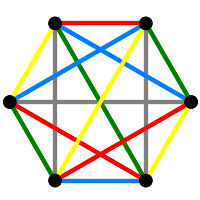Section5.3A Faithful Action on Factorizations
We will need the vertices and factorizations of \(K_6\) in this section, so run the following cell to repeat essential computations from the previous sections.
Automorphisms of a graph are permutations of the vertex set, which when applied to pairs of vertices, take edges to edges, and take non-edges to non-edges. Because every possible edge is present in \(K_6\), every permutation of the vertices is an automorphism. So we can build this automorphism group easily.
In this section we will show that the group of automorphisms of \(K_6\), as a group action on the set of factorizations, is a faithful group action. This means that no nontrivial element of the group fixes all of the factorizations, or equivalently, the mapping from an automorphism to a permutation of the factorizations is injective. First, we define a group action on the edges of \(K_6\), use it to define a group action on factors of \(K_6\), and then define a group action on factorizations of \(K_6\).
We give an illustration of this action with a 6-cycle from the automorphism group acting on the third factorization, with the result of the action being the fourth factorization. We accumulate the various items as strings in a list, then join them together to print in a readable way.
We can apply an automorphism to each factorization, creating a permutation of the factorizations. Employing the full permutation group of the factorizations, we check that the action only creates the identity permutation of the factorizations in the case of the identity automorphism. In other words, the mapping from the automorphism group of the graph to the permutation group of the factorizations is injective, which we describe by saying the action is faithful, or by saying the automorphism group acts “faithfully” on the factorizations.
We apply each of the \(6!=720\) automorphisms to each factorization, creating an ordered list of images which we use to define the resulting element of the permutation group of the factorizations. This permutation is checked to see if it is the identity permutation, and if so it is saved in the list. We expect to see only the identity automorphism. This command may take a little while to run, but it is instructive. There are more sensible ways to check computationally if the action is faithful (such as the result of the action for a set of generators of the group).
